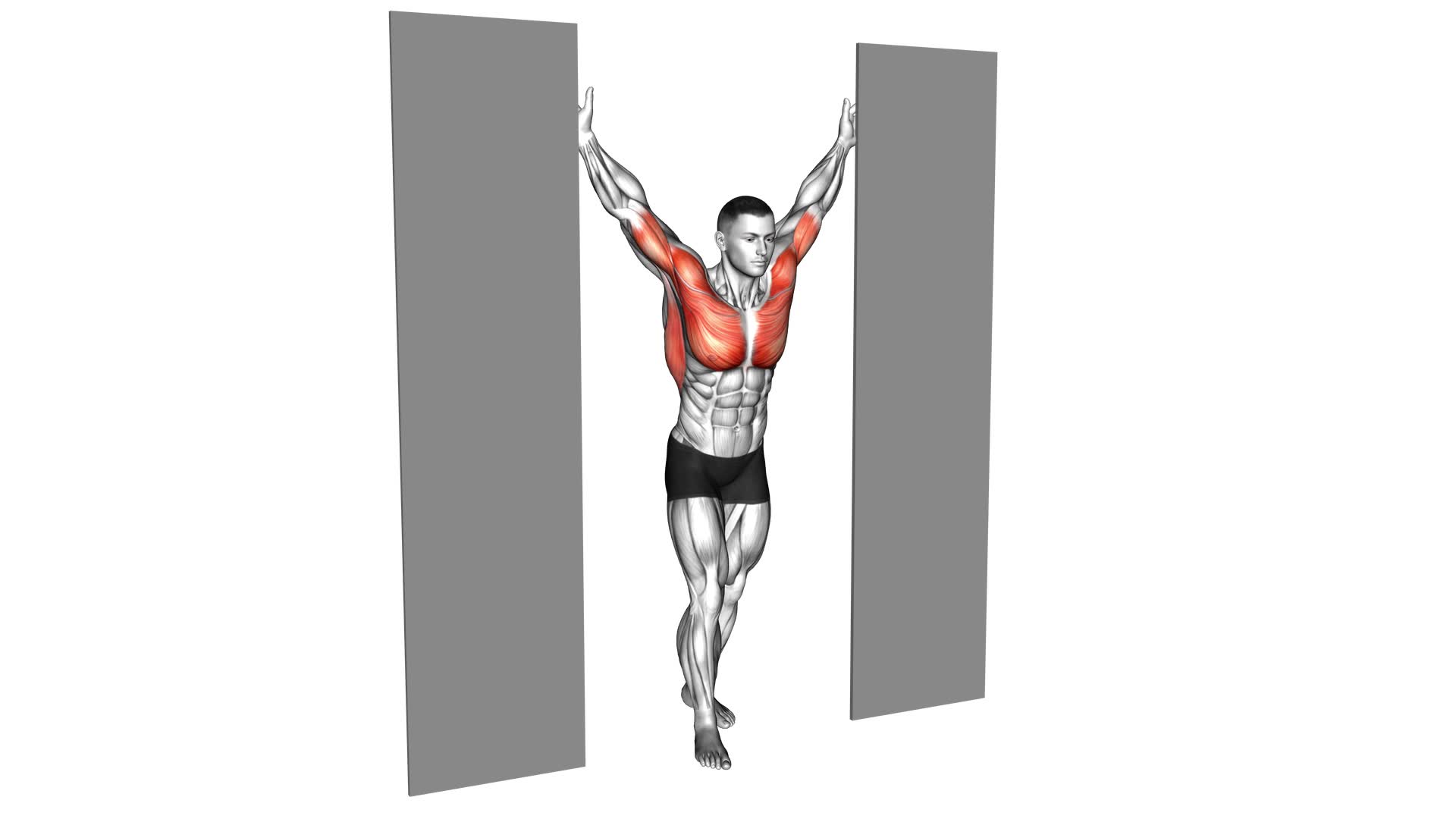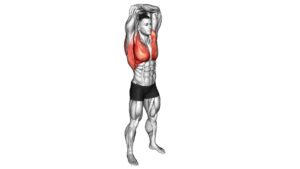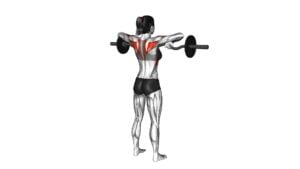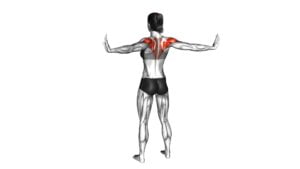Standing Upright Shoulders Stretch – Video Exercise Guide & Tips

Get ready to improve your shoulder flexibility with the Standing Upright Shoulders Stretch! This exercise offers numerous benefits for your upper body health and can be easily incorporated into your fitness routine.
Watch This Exercise Video
In this video exercise guide, you'll learn the proper form and technique, as well as common mistakes to avoid. Whether you're a beginner or an advanced fitness enthusiast, there are modifications and variations to suit your level.
Follow the tips provided to maximize the effectiveness of this stretch and ensure your safety throughout.
Let's get started!
Key Takeaways
- Improved flexibility
- Reduced shoulder tension
- Targets muscles in shoulders and upper back
- Increases range of motion
Benefits of the Standing Upright Shoulders Stretch
You will experience improved flexibility and reduced shoulder tension when performing the standing upright shoulders stretch. This stretch targets the muscles in the shoulders and upper back, helping to increase range of motion and alleviate tightness. By incorporating this stretch into your routine, you can enhance your overall shoulder flexibility and improve your posture.
The standing upright shoulders stretch is a simple exercise that can be done anywhere, making it a convenient option for those with busy schedules. To perform this stretch, start by standing tall with your feet shoulder-width apart. Place your hands behind your head, with your elbows pointing out to the sides. Gently squeeze your shoulder blades together as you push your elbows back. Hold this position for 15-30 seconds, feeling a gentle stretch in your shoulders and upper back. Remember to breathe deeply and relax into the stretch.
Regularly practicing the standing upright shoulders stretch can help relieve tension and stiffness in the shoulders, especially if you spend a lot of time sitting or working at a computer. This stretch can also improve your posture by opening up the chest and strengthening the muscles that support proper alignment. Incorporate the standing upright shoulders stretch into your daily routine to reap the benefits of improved shoulder flexibility and reduced tension.
Proper Form and Technique for the Stretch
To perform the standing upright shoulders stretch with proper form and technique, focus on maintaining a tall posture and squeezing your shoulder blades together as you push your elbows back. This stretch is a great way to relieve tension and improve flexibility in your shoulders.
It's important to debunk some common misconceptions about this stretch. One misconception is that you need to forcefully pull your shoulders back, which can lead to strain and injury. Instead, focus on a gentle squeeze of the shoulder blades together, allowing the stretch to be controlled and comfortable.
Another misconception is that this stretch is the only way to target the shoulders. While it's effective, there are alternative stretches you can incorporate into your routine to target different parts of the shoulders. These alternatives include lateral raises, shoulder rotations, and arm circles. By incorporating a variety of stretches, you can ensure a well-rounded shoulder stretching routine.
Now, let's move on to the next section to discuss common mistakes to avoid during the stretch.
Common Mistakes to Avoid During the Stretch
When performing the standing upright shoulders stretch, it's important to avoid certain common mistakes.
One mistake to avoid is incorrect posture, such as slouching or rounding the shoulders. This can prevent you from fully stretching the targeted muscles and may even lead to strain or injury.
Another mistake to avoid is overstretching the shoulder muscles, as this can also lead to strain or discomfort.
Lastly, make sure to engage your core muscles throughout the stretch to maintain stability and support for your upper body.
Incorrect Posture Mistakes
While stretching your shoulders, it's important to avoid common mistakes in posture. Proper posture not only enhances the effectiveness of the stretch but also prevents potential injuries. Here are some posture tips to help you correct slouching during the shoulder stretch:
- Maintain an upright position: Stand tall with your feet shoulder-width apart and your spine aligned.
- Engage your core: Activate your abdominal muscles to stabilize your trunk and prevent excessive arching or rounding of the back.
By following these posture tips, you can ensure that you're getting the most out of your shoulder stretch while minimizing the risk of strain or discomfort.
Overstretching Shoulder Muscles
To avoid overstretching your shoulder muscles during the stretch, focus on maintaining proper form and alignment. Overstretching can lead to injury and hinder your progress in shoulder mobility exercises. It's important to be aware of the risks involved and take precautions to prevent overstretching.
One common mistake to avoid is pushing your shoulders too far back or lifting them too high during the stretch. This can put excessive strain on the muscles and joints, increasing the risk of injury. Instead, aim for a gentle and controlled movement that allows for a comfortable stretch without going beyond your range of motion.
Another mistake is holding the stretch for too long. While it's important to hold the stretch for an adequate amount of time to promote flexibility, holding it for too long can lead to overstretching. It's recommended to hold each stretch for 15-30 seconds and repeat the exercise as needed.
Not Engaging Core Muscles
Engage your core muscles to maintain stability and proper alignment during the standing upright shoulders stretch. By neglecting to engage your core, you risk compromising your form and potentially straining your back.
Here are some common mistakes to avoid:
- Allowing your stomach to sag: Keep your abdominal muscles activated throughout the stretch to support your spine and prevent excessive arching.
- Not breathing properly: Remember to breathe deeply and rhythmically, as this helps to oxygenate your muscles and maintain focus.
- Focusing solely on the shoulders: While the primary target of the stretch is the shoulders, it's important to engage your core to strengthen your back and maintain overall stability.
Modifications and Variations for Different Fitness Levels
Now let's explore some modifications and variations for different fitness levels when performing the standing upright shoulders stretch.
If you're a beginner, there are beginner-friendly shoulder stretches that can help you gradually improve your flexibility.
For those who are more advanced, there are advanced modifications that can challenge your muscles even further.
Additionally, if you have limited mobility, there are adaptations you can make to still benefit from this stretch.
Beginner-Friendly Shoulder Stretches
Start by gently stretching your shoulders to increase flexibility and relieve tension. Incorporating shoulder mobility exercises into your routine can improve your range of motion and help prevent injury. Here are some beginner-friendly shoulder stretches for flexibility:
- Wall Shoulder Stretch:
- Stand facing a wall with your feet hip-width apart.
- Place your hands on the wall at shoulder height.
- Walk your feet back until your body is at a slight angle.
- Gently lean forward, feeling the stretch in your shoulders.
- Hold for 20-30 seconds and repeat.
- Shoulder Circles:
- Stand with your feet shoulder-width apart.
- Extend your arms out to the sides, parallel to the floor.
- Slowly rotate your arms in small circles, first forward and then backward.
- Repeat for 10-15 circles in each direction.
Remember to listen to your body and never force a stretch. Start with these beginner-friendly shoulder stretches and gradually increase intensity as you become more comfortable.
Advanced Modifications for Experts
As you progress in your shoulder stretching routine, there are advanced modifications and variations that can be incorporated to challenge your fitness level and further enhance your shoulder mobility. These expert techniques aim to push your limits and take your shoulder stretching to the next level.
One advanced modification is the use of resistance bands. By attaching a resistance band to a stable object and pulling it towards you while performing shoulder stretches, you can increase the intensity and resistance of the exercise.
Another modification is performing shoulder stretches on an unstable surface, such as a stability ball or a Bosu ball. This challenges your balance and stability, forcing your shoulder muscles to work harder.
Additionally, incorporating dynamic movements, such as arm circles or shoulder rotations, can help improve your range of motion and flexibility.
Remember to consult with a fitness professional before attempting these advanced modifications to ensure proper form and technique.
Adaptations for Limited Mobility
As you progress in your shoulder stretching routine and adapt for limited mobility, incorporating modifications and variations can help accommodate different fitness levels and enhance shoulder mobility. Here are some adaptations for disabilities and modified shoulder stretches:
- Adaptations for Disabilities:
- Use a resistance band: If you have limited mobility or strength in your shoulders, using a resistance band can provide support and assistance during the stretches.
- Chair or wall support: If standing is challenging, you can perform the shoulder stretches while sitting in a chair or using a wall for support.
- Modified Shoulder Stretches:
- Arm circles: Instead of extending your arms fully, perform smaller arm circles to reduce strain on the shoulders.
- Shoulder rolls: Instead of rolling both shoulders simultaneously, you can roll one shoulder at a time to focus on individual mobility.
Tips to Maximize the Effectiveness of the Shoulder Stretch
To maximize the effectiveness of your shoulder stretch, make sure to maintain proper form and engage your core muscles throughout the exercise. By doing so, you can maximize flexibility and improve your posture.
When performing the shoulder stretch, stand tall with your feet hip-width apart and your shoulders relaxed. Begin by interlacing your fingers behind your back and gently straightening your arms. As you do this, focus on pulling your shoulder blades together and down. This will help to open up your chest and stretch the front of your shoulders.
Remember to breathe deeply and relax your neck and jaw. By engaging your core muscles, you'll provide stability and support to your spine, allowing for a deeper stretch. Additionally, engaging your core will help to protect your lower back and prevent any strain or injury.
By following these tips, you can maximize the effectiveness of your shoulder stretch and experience the benefits of improved flexibility and posture.
Now, let's move on to the next section where we'll discuss precautions and safety guidelines for the stretch to ensure that you perform it safely and avoid any potential injuries.
Precautions and Safety Guidelines for the Stretch
To ensure your safety and prevent injuries while performing the standing upright shoulders stretch, it's important to follow these precautions and safety guidelines:
- Consult a healthcare professional: If you have any existing shoulder injuries or medical conditions, it's crucial to consult a healthcare professional before attempting this stretch. They can provide personalized advice and modifications based on your specific needs.
- Warm up: Prior to performing the standing upright shoulders stretch, it's recommended to warm up your muscles to reduce the risk of strain or injury. Engage in light aerobic exercise or dynamic stretches to increase blood flow and prepare your body for the stretch.
- Maintain proper form: It's essential to maintain proper form throughout the stretch to avoid unnecessary strain on your shoulders. Keep your spine straight, shoulders relaxed, and avoid arching your back. Engage your core muscles to support your posture.
- Avoid overstretching: Don't force the stretch beyond your comfort level. Gradually increase the range of motion over time, listening to your body's signals. Stop immediately if you experience any pain or discomfort.
- Breathe: Remember to breathe deeply and exhale as you stretch. This helps relax your muscles and promote a greater range of motion.
Frequently Asked Questions
Can the Standing Upright Shoulders Stretch Help Improve Posture?
Yes, the standing upright shoulders stretch can help improve your posture. By regularly performing this exercise, you can strengthen the muscles in your shoulders, upper back, and neck, which are essential for maintaining good posture.
The standing upright shoulders stretch benefits include relieving tension and tightness in these areas, promoting better alignment, and reducing the risk of developing rounded shoulders.
To ensure proper form for the standing upright shoulders stretch, stand tall, keep your core engaged, and gently pull your shoulders back and down.
How Often Should the Standing Upright Shoulders Stretch Be Performed for Optimal Results?
To achieve optimal results in improving shoulder flexibility and incorporating the standing upright shoulders stretch into your stretching routine, it's important to perform this exercise regularly.
The frequency at which you should do this stretch depends on your individual goals and needs. However, for the best outcome, it's generally recommended to perform the standing upright shoulders stretch at least 2-3 times a week.
This will help promote better posture and enhance overall shoulder mobility.
Can the Standing Upright Shoulders Stretch Help Alleviate Shoulder Pain?
The standing upright shoulders stretch can be a helpful exercise in alleviating shoulder pain. By stretching the muscles in your shoulders, this exercise can improve flexibility and reduce tension.
However, it's important to note that results may vary for each individual. If you're experiencing shoulder pain, it's recommended to consult with a healthcare professional for a proper diagnosis and to explore alternative shoulder pain exercises that may be more suitable for your specific condition.
Are There Any Specific Warm-Up Exercises Recommended Before Performing the Standing Upright Shoulders Stretch?
Before performing the standing upright shoulders stretch, it's important to incorporate specific warm-up exercises into your pre-stretch routine. These exercises help prepare your muscles and joints for the stretch, reducing the risk of injury.
By targeting the shoulder area with gentle movements and stretches, you can increase blood flow and flexibility, ensuring a more effective and safe stretching session.
Including a warm-up routine before the standing upright shoulders stretch is highly recommended for optimal results.
Can the Standing Upright Shoulders Stretch Be Done With Weights or Resistance Bands to Increase Intensity?
To increase the intensity of the standing upright shoulders stretch, you can incorporate weights or resistance bands. This allows you to challenge your muscles and promote further strength and flexibility.
Adding weights or resistance bands can help to target different muscle groups and provide a more comprehensive workout. However, it's important to use proper form and start with lighter weights or resistance bands to avoid injury.
Always consult with a fitness professional for alternative exercises that suit your fitness level and goals.
Conclusion
In conclusion, the standing upright shoulders stretch is a beneficial exercise for improving shoulder flexibility and reducing tension.
By following proper form and technique, avoiding common mistakes, and making modifications for different fitness levels, individuals can maximize the effectiveness of this stretch.
It's important to adhere to precautions and safety guidelines to prevent injury.
Incorporating this stretch into a regular fitness routine can contribute to overall shoulder health and mobility.

Author
Years ago, the spark of my life’s passion ignited in my mind the moment I stepped into the local gym for the first time. The inaugural bead of perspiration, the initial endeavor, the very first surge of endorphins, and a sense of pride that washed over me post-workout marked the beginning of my deep-seated interest in strength sports, fitness, and sports nutrition. This very curiosity blossomed rapidly into a profound fascination, propelling me to earn a Master’s degree in Physical Education from the Academy of Physical Education in Krakow, followed by a Sports Manager diploma from the Jagiellonian University. My journey of growth led me to gain more specialized qualifications, such as being a certified personal trainer with a focus on sports dietetics, a lifeguard, and an instructor for wellness and corrective gymnastics. Theoretical knowledge paired seamlessly with practical experience, reinforcing my belief that the transformation of individuals under my guidance was also a reflection of my personal growth. This belief holds true even today. Each day, I strive to push the boundaries and explore new realms. These realms gently elevate me to greater heights. The unique combination of passion for my field and the continuous quest for growth fuels my drive to break new ground.







